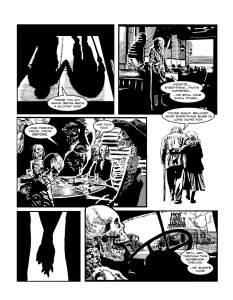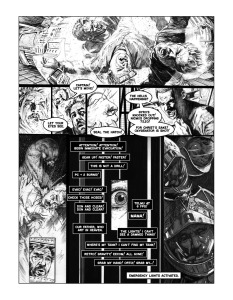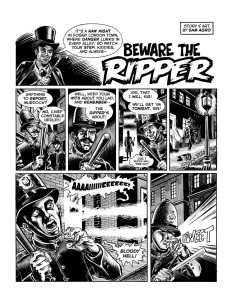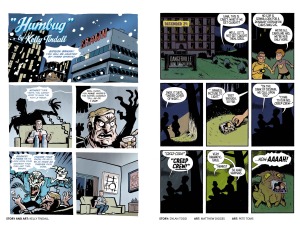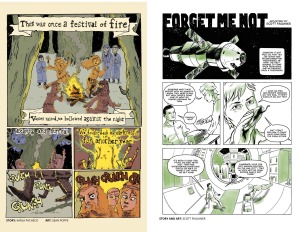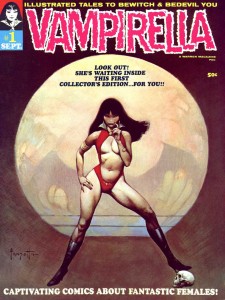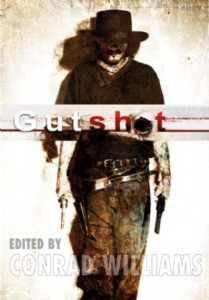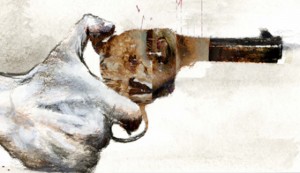(Kim Roberts/Various Writers and Artists; 80 pages; WP COMICS; 2016)
The English people are a weird lot. They have a very dry, wicked sense of humor. They have also given us some of THE most frightening tales of horror… ever! Their views on Christmas are… let’s go with “skewed,” shall we? It goes well beyond the fact that they maintain a stubborn habit of saying “Happy” rather than “Merry” when wishing one well during the season of goodwill. Many of those views have been engrained for centuries; well before, I’m sure, the Church usurped the holy days, celebrations and traditions surrounding the winter solstice. All of this is my wholly American way of introducing you to a relatively new comic from the UK called CHRONICLES OF TERROR and, in particular, the fourth issue, a collection of Christmas themed stories sub-titled “Santa’s Twisted Tales.” Now, to be certain, all of the pieces here do not come from the minds and hands of our stalwart British friends; in point of fact, a “Creator of the Month” feature highlights Ohio comics writer and publisher of Disposable Fiction Comics, Jack Wallace.

Starting with the magnificent, delightfully gruesome cover image by Haraldo (like Cher, I suppose, this artistic genius only needs the one name), this book takes on every traditional concept – both religious and secular – regarding Christmas, as well as the so-called “pagan” rites and rituals of more ancient (some would say “arcane”) holy days. Haraldo’s stunning artwork is back in an imaginative take on the old “revenge is a dish best served cold” proverb; with a brilliant story and script by anthology editor, Kim Roberts, “Snowvenge” is certainly setting the bar high as an opening salvo, as it hits on all cylinders, from concept to finished art. “The Never” is a cautionary tale from the twisted brain of writer Eric Gahagan… a warning from the Anti-Santa for children everywhere about peeking at their presents. Pietro Vaughan’s hard angular lines and thick black shadows are akin to the fever-dream sets used in the brilliant, century old German expressionist horror film, THE CABINET OF DOCTOR CALIGARI. Ever wonder what the Jolly Elf’s reindeer eat to keep their energy up on those long Christmas Eve journey? Paul Bradford and artist Allen Byrns paint a very vivid picture in “Reindeer: Oh, Deer – Oh, Dear.”

Gabe Ostley’s obscenely off-kilter “Charles ‘Chucky’ Dickens’ A Christmas Carol” is eight pages of wildly gratuitous violence featuring the obligatory firefight between Death and Satan and his goat-minions, as well as Cthulhu, the festering corpse of the famed author of THE STORY OF THE GOBLINS WHO STOLE A SEXTON (if I’m not mistaken, he may have written some other fairly famous pieces, as well) and, of course, the totally unlikeable (anti-)hero of the story, a rooster named Cluck, appearing here as Scrooge McCluck; as Cluck is so repellant, I cannot wait for another installment of his adventures. Chris Allen’s vivid palette adds to the already surreal Hellscape. “The Ancestors” delves into some of the “pagan” beliefs and rituals that have become a part of traditional Christmas celebrations. MC Carper’s art has an old-world quality that fits Hunter Eden’s story perfectly, just as Chris Allen’s colors suit Carper’s line-work. As people of varying cultures and religions have migrated farther and farther from the homes of their fathers, the desire to break away from those familial and cultural bonds has grown, even as the need to remain grounded in those cultures and religions is instilled by the ancestral ways invariably follow (and, sometimes, haunt) the immigrant; this story follows one such tortured soul to his own inevitable conclusion. Though only three pages in length, “The Book of Eden Z: Come Gentle Christmas Angels” is… beautiful. The story is simple, elegant and sentimental; I’m not ashamed to say that it brought a lump to my throat and a tear to my eye. What do the spirits of children who are the victims of some unexpected violence wish for on Christmas? J Christopher Greulich’s story is both heart-warming and heartbreaking and his magnificent black and white art is among the best in this volume.

“Bad Santa,” from writers Kim Roberts and Chris Allen and artist Braden Hallett is a cautionary tale of greed and the importance of inspecting each and every package, making sure to read any and all warning notices… even hand-written ones from in-house quality-control engineers. James Johnson’s “Unwanted Gifts” holds the least appeal, story-wise, for me. I don’t know why… it has so many horror linchpins: Loving family set upon by demon spores/spirits/whatevers living in the limbs of the family’s chosen fir tree, each possession driving the inhabited family member over the edge and, as they succumb to their inhabitants, further into the world of ancient Solstice religious beliefs and secular Christmas traditions. Maybe that’s the problem: Johnson’s plot is just too chock full of thoughts and ideas and visions to be coherent enough for a numbskull like me. The blood and the guts (yards and yards of guts!) and the extreme mayhem are cool, though. A drunken stepfather, an uncaring mother and an alien monster all impact poor little Sidney as she awaits a visit from Santa Claus on “Christmas Eve,” though, maybe not in the way that you would imagine. Jojo King’s story does a fine job of exploring the young girl’s hopes and wishes, while the artwork of Alister Lee aptly relates the horror of the season. The ending is much more graphic but is still very reminiscent of this issue’s earlier “Reindeer: Oh, Deer – Oh, Dear.”

The remainder of this fourth issue of CHRONICLES OF TERROR is comprised of special features and pin-ups, including a killer pin-up by Gabe Ostley (with suitably bright colors from Chris Allen) called “Christmas Turkey.” As mentioned earlier, a “Creator of the Month” feature focuses on Jack Wallace, writer and co-publisher (with the by-now ubiquitous Chris Allen) at Disposable Fiction Comics, who discusses his entrance into the comics industry, working with a wide variety of artistic talents and the pitfalls of self-publishing. Following this in-depth profile is a five page preview of Wallace’s latest graphic novel, THE 512TH DAY OF CHRISTMAS, with magnificent art from Reinaldo Lay Contreras (better known as Rei Lay) and colors from… you guessed it: Chris Allen. More info about and ordering info for the book is available at Disposable Fiction Comics; plus, you can order your own copy (physical or digital) of this Yule-themed CHRONICLES OF TERROR (as well as the first three issues of the incredible anthology) here. Enjoy! And… Merry Christmas, one and all.



